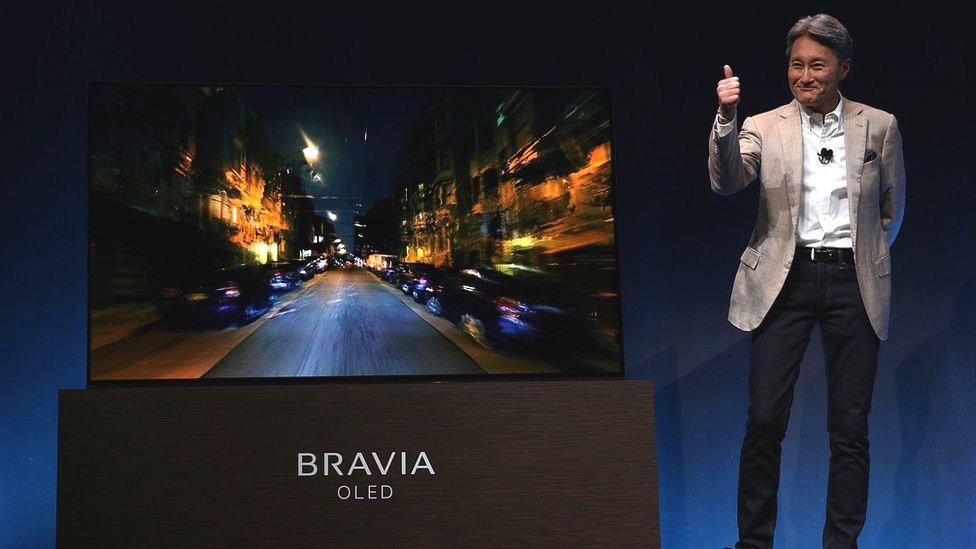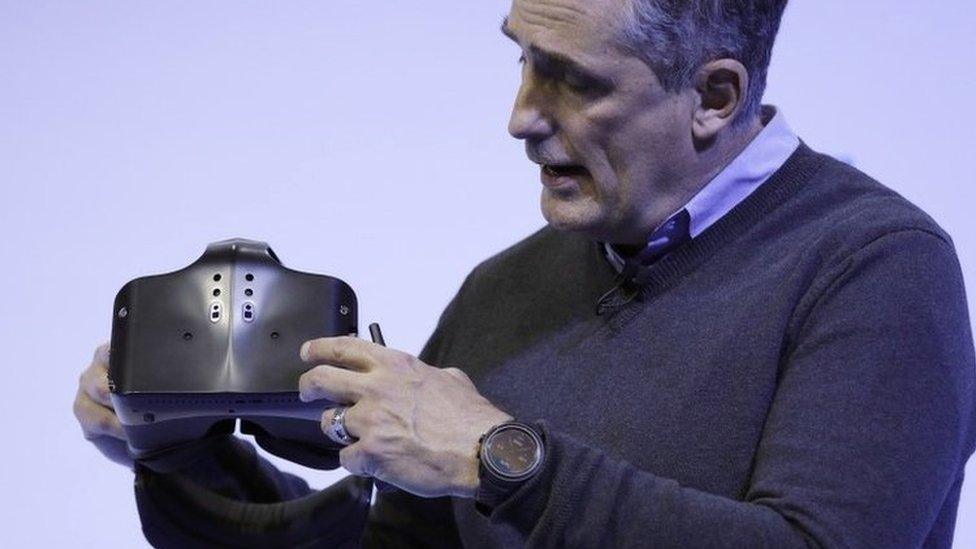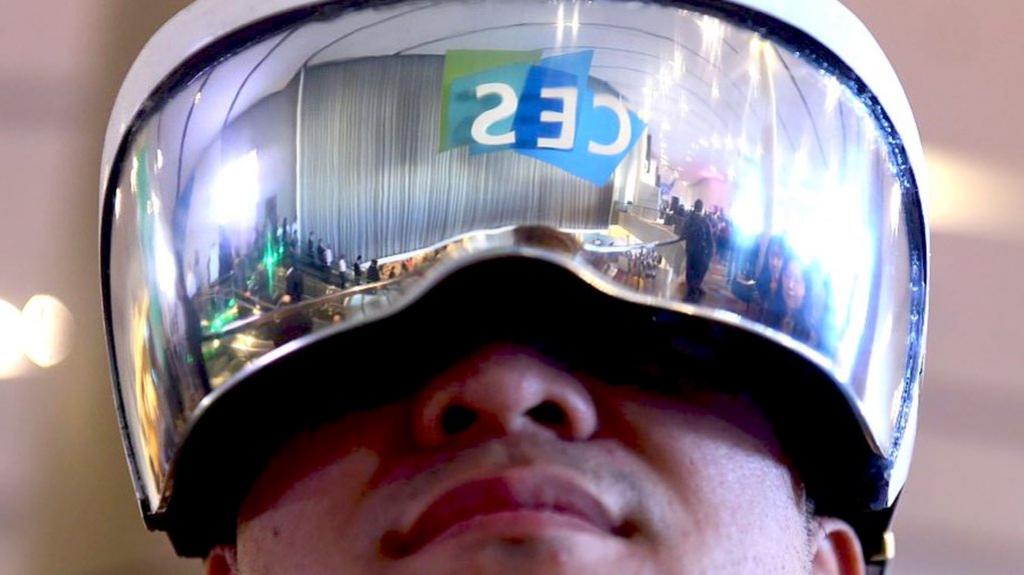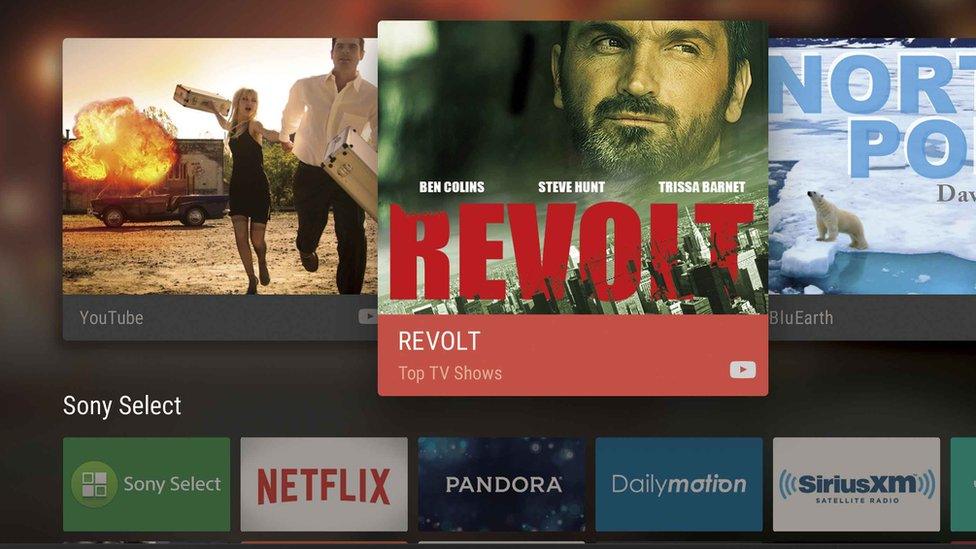CES 2017: Samsung and LG TVs battle to blend in
- Published
LG unveiled its "wallpaper TV' at the CES tech show in Las Vegas
South Korean tech giants LG and Samsung have launched TVs that aim to better blend in to consumers' living rooms.
LG showed off a set that can be fitted almost flat against a wall while Samsung teased a new kind of TV - designed to look like a painting - that displays art when not in use.
Samsung also unveiled a flagship set boasting greater brightness levels than before.
Others, including Sony, also revealed new models.
Samsung's flagship 75in (190cm) QLED 4K TV features the latest version of its quantum dot technology - tiny particles that emit different colours of light. These now feature a metal material that the firm says allows for better colour reproduction.
Samsung has decided to stick with a curved display for its high-end models - despite criticism from some experts that viewing angles suffer with such designs.

Samsung's quantum dots are tiny particles that emit light of different colours
'Insanely bright'
The QLED TV can achieve HDR (high dynamic range) brightness of between 1,500 and 2,000 nits - one nit equalling the light from a candle.
"It's insanely bright," said Jack Wetherill, a tech analyst at Futuresource.
"That is pretty power hungry one would imagine, but if they're going down the route of getting as good a picture as they can out of it, then fair enough."
This sets it apart from other set makers who use another premium TV screen technology, OLED (organic light-emitting diode).
Such screens use a carbon-based film allowing the panel to emit its own light, rather than being backlit - this enables the ultra thin designs.
Quantum dot TVs might not be able to display the deepest blacks possible with OLED, but they are generally brighter.

LG's newest TV sticks out just 3.85mm from a wall when mounted against it
LG's new OLED 4K TV was as thin as last year's - just 2.57mm thick - and will be available in 65 and 77in models.
But the firm has now designed a new mount that uses magnets so the set can be fixed flat against a wall, which the firm says means it doesn't cast "a single shadow".
HDR ready
LG also announced its latest TVs would support four HDR formats - including Hybrid Log-Gamma jointly developed by the BBC and the Japanese broadcaster NHK. This will allow sport and other live broadcasts to be shown in the format.
Many experts agree that HDR makes a huge difference to the TV picture, making it seem richer and allowing for higher levels of contrast between light and dark tones.
"It is more vibrant, the colours are more distinctive," said Mr Wetherill.
"It does bring a much more impressive and immersive experience - no question about that."
It is not yet clear which format will become popular with content-makers, so LG's inclusion of all four should ensure it does not become obsolete if and when a winner emerges.

The Samsung Lifestyle TV could be mistaken for a painting
Samsung also showed off images of its new Lifestyle TV, which it described as "a beautiful, always-on, truly smart display that transforms the TV to art".
It comes in a wooden frame, in an attempt to look like a painting.
Sony also announced a new 4K OLED TV - its first - the latest in its Bravia range.
As well as an HDR processor that can upscale standard dynamic range content to "near 4K HDR quality", the set has also dispensed with in-built speakers.
Instead, it emits sound via vibrations produced on the surface of the screen itself.

The new Bravia TV doesn't have speakers - the screen vibrates instead, which emits sounds
This wasn't demonstrated at the press conference, noted Mr Wetherill, but it was, he said, "an interesting concept".
Panasonic did not discuss its OLED TV plans at its press conference, though it is possible a prototype will be on the CES trade show floor.
At last year's consumer electronics show IFA in Berlin, the company had said it would release details of the TV during the winter.


More from CES 2017:
Follow all our CES coverage at bbc.co.uk/ces2017, external

- Published2 January 2017

- Published6 January 2016

- Published6 September 2016
